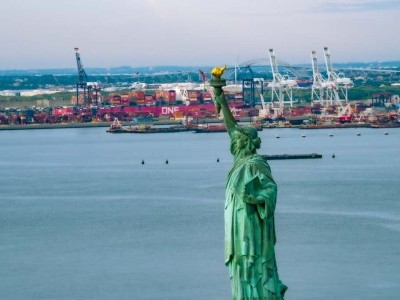The ports are weather vanes as economic clouds darken
So the dockworker is an important weather vane of a U.S. economy, still buffeted by Washington’s increased tariffs on some $370 billion in Chinese imports and now by a health crisis that paralyzed China’s economy and is widening in the world’s top economic powers, Europe and America.
At the neighboring ports of Los Angeles and Long Beach, the two busiest in the U.S. and the main entry points for Chinese goods, work shifts so far this year have dropped 21% compared with the same period a year ago, according to the Pacific Maritime Association. Both facilities just released their February container volumes: Long Beach’s imports dropped 18% from a year earlier, L.A.’s sank 23%.
More broadly, U.S. seaports could see slowdowns of as much as 20% continue into March and much of April, according to the American Association of Port Authorities. The same trend is seen in more distant places, with Rotterdam — Europe’s economic gateway to Asia and beyond — seeing a similar cut of about 20%.
Dockworkers feel the effects before the downdraft hits truckers, farmers, railroads, distribution centers, stores and showrooms. Work opportunities for members of the International Longshore and Warehouse Union in Los Angeles were cut recently and shifts have completely dried up for so-called “casuals,” certain port workers who are not union members, according to ILWU.
What’s happening at ports might well be short-lived, leaving the next challenge of coping with the empty shipping containers that are piling up on U.S. shores because fewer vessels are arriving to take them away. “Once the virus is contained, we may see a surge of cargo, and our terminals, labor and supply chain will be ready to handle it,” says Mario Cordero, executive director at Long Beach.
But if that snapback doesn’t occur and the slump drags on for months, the economic and political importance of ports and their workers may rise to the forefront again in places that connect the U.S. to key markets overseas, like Virginia, South Carolina, Georgia and Texas.
Similar Stories

Strike updates on Canada’s West Coast and Port of Montreal
View ArticlePorts awarded more than half a billion in MARAD PIDP Grants
The $580 million in grants awarded today range in size from more than $53 million for the Port of San Juan Puerto Rico to restore key wharves to $708,750 for…
View Article
Port of Hamburg: Sustained growth in hinterland transports
View Article
Port of Hueneme and Port of Paita sign MoU to establish a sister port relationship
View Article
New electric yard truck helps Port of Tacoma demonstrate zero-emission technology
View Article
Port Authority of NYNJ proposes $9.4 billion budget for 2025
View ArticleGet the most up-to-date trending news!
SubscribeIndustry updates and weekly newsletter direct to your inbox!





